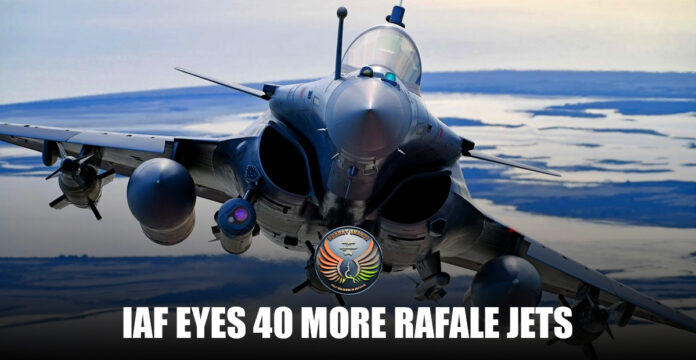In a decisive move to shore up India’s dwindling air combat strength, the Indian Air Force (IAF) is reportedly preparing to procure 40 additional Rafale fighter jets from France through a government-to-government (G2G) deal—parallel to the imminent Rafale-M contract for the Indian Navy, which is likely to be signed in Delhi on April 28 or 29 when the French Defence Minister visits India.
Highly placed sources have confirmed to BharatShakti that high-level talks have been held recently between Indian and French officials, not just to conclude engine-related discussions with Safran for India’s helicopter programme but also to initiate groundwork on a second tranche of Rafale fighters for the IAF under what is being described as a fast-tracked MRFA-plus agreement.
This potential deal is separate from the Navy’s Rafale-M acquisition but is being viewed in strategic circles as part of a larger consolidation of India’s air combat ecosystem—centred around the French fighter platform. The IAF, still operating with only 31 squadrons against a sanctioned strength of 42.5, has flagged its operational crunch repeatedly over the last few years.
IAF’s Fighter Crisis: A Gap Too Wide
Earlier this year, Air Chief Marshal AP Singh underlined the force’s need to induct 35–40 new fighters annually to compensate for squadron depletions and legacy aircraft retirements. While Hindustan Aeronautics Limited (HAL) is gearing up to deliver 97 Tejas Mk-1A jets by 2030, the pace of production, infrastructure readiness, and the sheer scale of requirements have forced the IAF to look outward—again.
The Multi-Role Fighter Aircraft (MRFA) project, aimed at inducting 114 foreign fighters under a competitive tender, has been in limbo with no Request for Proposal (RFP) issued. But insiders confirm that in light of urgent requirements and the operational familiarity with the Rafale platform, the French jet has emerged as the clear frontrunner—sidestepping the traditional contest route.
“Both sides have reached a strategic understanding. This is not just a purchase—it’s a continuity plan,” said a senior official familiar with the negotiations.
Navy’s Rafale-M Deal: The First Domino
Meanwhile, the Indian Navy is on the brink of signing a ₹63,000-crore (approx. $7.5 billion) contract for 26 Rafale-M fighters. Cleared by the Cabinet Committee on Security (CCS) earlier this month, the deal includes 22 single-seat carrier-based fighters and four twin-seat trainers. These jets will operate from INS Vikrant and replace the ageing MiG-29K fleet.
Deliveries are slated to begin around 2028, with full induction by 2031. Importantly, the Navy contract includes weapon packages, Astra missile integration, indigenous MRO facilities, and crew training—all of which are expected to boost the IAF’s Rafale ecosystem as well.
Ten of the IAF’s 36 Rafale fighters are also being upgraded under a parallel track to incorporate mid-air refuelling pods (buddy-buddy refuelling), enhanced sensors, and extended-range software suites, further underlining India’s long-term reliance on the Rafale platform.
Why Rafale, Again?
Combat-tested in Syria, Libya, and Mali and proven in Indian skies during high-altitude operations in Ladakh, the Rafale has become a linchpin in India’s deterrence posture. With advanced payload capabilities, Meteor air-to-air missiles, SCALP stand-off weapons, and AESA radar, it represents a generational leap over the IAF’s MiG-21, MiG-29, and Jaguar fleets.
Moreover, the near 95 per cent commonality between the IAF’s Rafale and the Navy’s Rafale-M ensures streamlined logistics, shared training modules, and reduced maintenance overhead—a rare convergence that makes a compelling case for standardization across services.
A G2G Model for Speed and Sovereignty
The shift away from open bidding under the MRFA framework to a G2G route is being framed as a strategic choice rather than a compromise. With threats evolving rapidly across two fronts and a timeline crunch for capacity building, the G2G model offers speed, assured delivery, and continuity.
Defence analysts argue that this approach also aligns with India’s ‘Make-in-India-for-the-World’ policy. Discussions are underway to ramp up domestic assembly, deepen industrial offsets, and create a robust MRO ecosystem for the Rafale in India—extending beyond just the IAF or Navy.
The Road Ahead: Momentum with Dassault
While competitors like the F-15EX, Eurofighter Typhoon, and Saab Gripen-E remain technically in contention under the original MRFA framework, the political and operational momentum is visibly tilted towards Dassault. The IAF’s familiarity with the Rafale, existing base infrastructure, and Navy interoperability gives the French aircraft a distinct edge.
If approved, the IAF’s second tranche of 40 Rafales will bring the total fleet strength to 76—equivalent to around four full squadrons. It would not only partially bridge the squadron deficit but also serve as a strategic counterbalance amid heightened regional military developments, including China’s rapid PLAAF modernization and Pakistan’s acquisition of J-10C fighters.
Huma Siddiqui






















